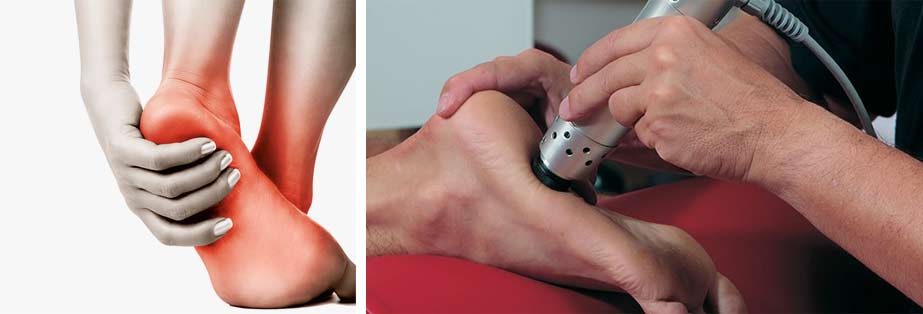
Extracorporeal Shock Wave Therapy (ESWT)
What is ESWT?
Extracorporeal Shock Wave Therapy (ESWT) is a noninvasive surgical procedure that uses sound waves to stimulate healing in some physical disorders, including plantar fasciitis. “ Extracorporeal” means “ outside of the body” and refers to the way the therapy is applied. Because there is no incision, ESWT offers two main advantages over traditional surgical methods: fewer potential complications and a faster return to normal activity. ESWT has been used extensively for several years to treat plantar fasciitis and other disorders.

What is Plantar Fasciitis?
Plantar fasciitis is the most common form of heel pain. This painful condition results from inflammation of the plantar fascia – the connective tissue that stretches from the heel bone, across the arch, and to the base of the toes. Plantar fasciitis is sometimes also called heel spur syndrome when a spur (bony protrusion) is present.
Who is a Candidate for ESWT?
ESWT may be considered as a therapeutic option for the patient whose heel pain has not resolved with conservative treatment. Conservative measures include use of anti-inflammatory medications, steroid injections, ice packs, stretching exercises, orthotic devices (shoe inserts), and physical therapy.
Some patients should not be treated with ESWT. The procedure is not appropriate for patients who have a bleeding disorder or take medications that may prolong bleeding or interfere with clotting. Your foot and ankle surgeon will determine if the procedure is appropriate for you based on your medical history.
What to Expect With ESWT?
In preparation for ESWT, the foot and ankle surgeon will instruct the patient to stop taking any anti-inflammatory medications (for example, aspirin or ibuprofen) for about five days before the procedure. It is important to avoid these medications because they are known to prolong bleeding under the surface of the skin.
ESWT is performed on an outpatient basis, so it does not require an overnight stay in the hospital. Before the procedure begins, the patient is comfortably positioned and may receive local and/or sedation anesthesia. The treatment may take up to 30 minutes per foot. During the procedure sound waves penetrate the heel area and stimulate the healing response. Sometimes more than one session is needed to adequately treat the inflammation and reduce the patient´s symptoms.
We Made Them All Happy
” I’m a heel lover. I love my pumps. Unfortunately, my bunions have made wearing them an excruciating experience for most of my life. Even just walking in general has been painful. I finally mustered up the courage to undergo surgery and I’m so glad I chose Dr.Jam. He is one of the most caring doctors I’ve dealt with. His gentle demeanor put me at ease and he explained everything about the procedure to me in full detail. I would recommend him to anyone seeking a stress free experience with this sort of thing.”
Kimberly D. / Los Angeles, CA
After the Procedure
The foot and ankle surgeon may advise you to have someone drive you home after the procedure. Other instructions may include:
- Rest and elevate the foot for the remainder of the day and night.
- Resume gentle stretching exercises the day following the procedure.
- Avoid taking any anti-inflammatory medication, such as ibuprofen or aspirin, for up to four weeks after ESWT.
- Avoid heavy lifting until the surgeon approves resuming this activity.
- You may walk on the foot.
- Avoid running or excessive activity.
- Avoid going barefoot during the healing process.
- Wear supportive shoes.
- In some instancesshoe inserts) will be prescribed.
Although patients sometimes feel they can return to normal activities right away, the surgeon will determine when that is appropriate for your situation. It is important to use caution and follow the doctor´s instructions to avoid injuring the treated foot. Because ESWT temporarily reduces or eliminates the sensation of pain, patients sometimes become too active too soon.
ESWT is very safe and effective, but every surgical procedure carries the possibility of complications. In addition to mild pain and tingling or numbness, bruising and swelling sometimes develop after ESWT. There have also been reports of rupture of the plantar fascia and damage to the blood vessels or nerves.





